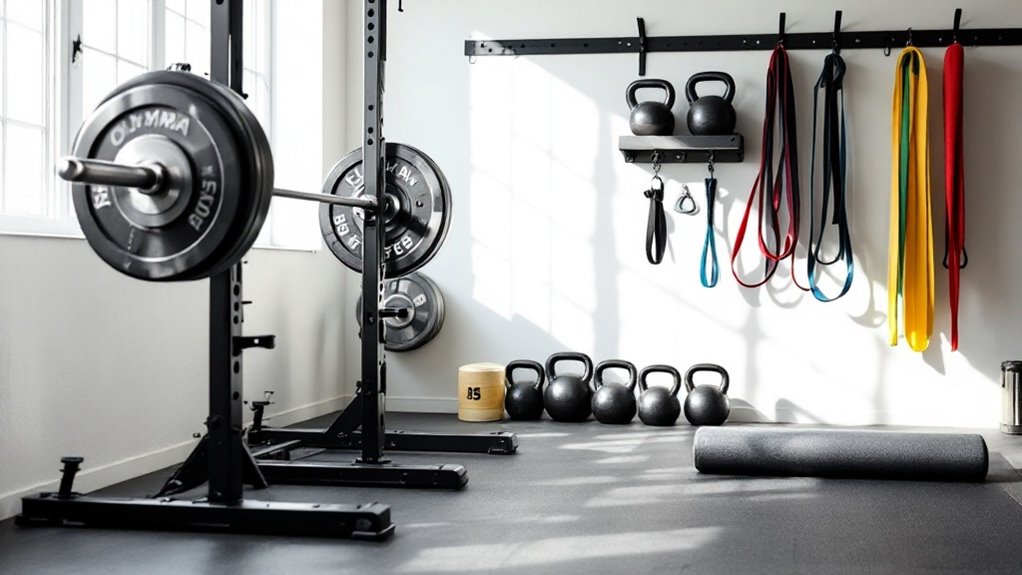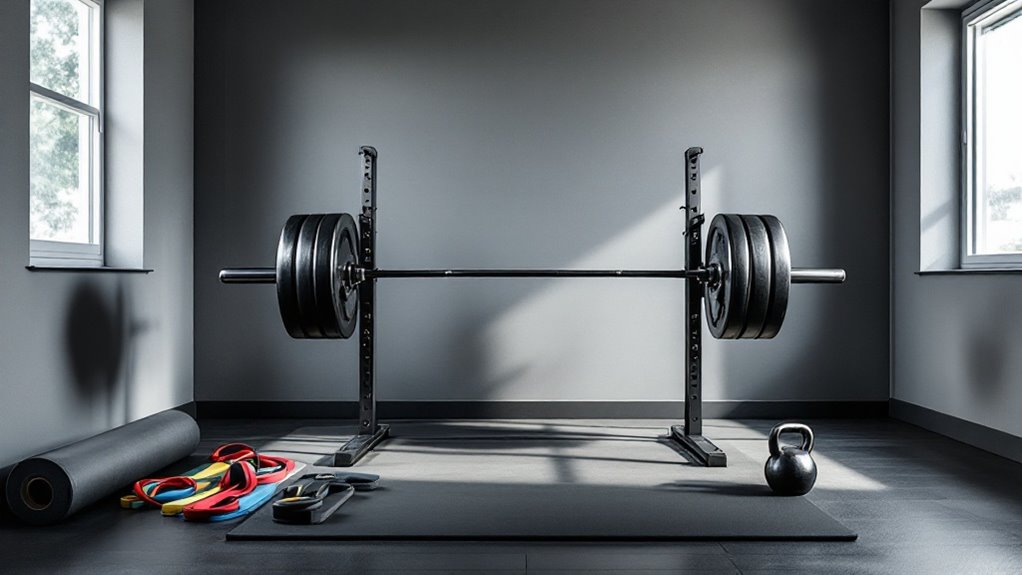Strength and Conditioning Program

A strength and conditioning program integrates progressive overload, structured periodization, and strategic exercise selection to build muscle and improve athletic performance. Proper form, consistent tracking, and adequate recovery protocols create the foundation for sustainable results. Regular assessment of metrics like sets, reps, and body composition guarantees continuous improvement. Systematic training combined with disciplined execution transforms fitness goals into measurable achievements. The journey toward peak performance begins with a proven framework.
Key Takeaways
- Progressive overload through systematic increases in weight, sets, and reps develops strength and improves conditioning over time.
- Incorporate both compound exercises and isolation movements, focusing on proper form and full range of motion.
- Structure workouts with periodization cycles to prevent plateaus and optimize gains through planned intensity variations.
- Balance strength training with cardiovascular conditioning while ensuring adequate recovery between sessions.
- Track performance metrics and body composition regularly to make data-driven adjustments to your training program.
Core Elements of an Effective Training Program

Building a successful strength and conditioning program requires several essential components working in harmony to produce ideal results.
These core elements include progressive overload, proper exercise selection, structured periodization, adequate recovery protocols, and systematic tracking of performance metrics.
A well-designed program incorporates both strength training and cardiovascular conditioning, tailored to specific fitness goals.
Like building a house, the foundation must be solid. Proper form and technique serve as the bedrock, while progressive resistance and intensity act as the framework.
Regular assessment and adaptation guarantee continuous improvement, preventing plateaus and maintaining forward momentum.
Effective muscle development depends on performing compound exercises like squats, deadlifts, and bench press that target multiple muscle groups simultaneously.
Designing Your Personal Workout Strategy

Creating a personalized workout strategy starts with an honest assessment of current fitness levels, available time, and specific goals. This foundational evaluation guarantees realistic program design and sustainable progress tracking.
The strategy should incorporate progressive overload principles, balancing strength training, cardiovascular conditioning, and recovery periods. Factors like exercise selection, training frequency, and intensity levels must coincide with individual capabilities and objectives.
Success requires methodical planning and consistent execution. Documenting workouts, monitoring progress, and adjusting the program based on performance feedback creates a dynamic strategy that evolves with increasing fitness levels.
This systematic approach optimizes results while minimizing injury risks.
Drawing inspiration from fitness transformation stories can help maintain motivation through challenging phases of your training journey.
Maximizing Results Through Proper Technique

While many fitness enthusiasts focus primarily on workout intensity and volume, proper technique serves as the cornerstone for maximizing exercise results and preventing injuries. Developing mindful movement patterns and maintaining correct form throughout exercises guarantees ideal muscle involvement and reduces the risk of strain or misalignment.
| Exercise Component | Common Mistakes | Proper Technique |
|---|---|---|
| Breathing | Holding breath | Controlled inhale/exhale |
| Joint Alignment | Poor posture | Neutral spine, aligned joints |
| Range of Motion | Incomplete movement | Full extension/contraction |
Understanding and implementing proper technique not only improves workout efficiency but also creates a solid foundation for progressive overload and sustained fitness development. Mastering technique in compound lifts like squats is essential for building foundational strength and achieving long-term fitness goals.
Tracking Progress and Making Adjustments

A systematic approach to tracking progress serves as the foundation for any successful strength and conditioning program. By consistently recording workouts, measurements, and performance metrics, athletes can identify patterns, strengths, and areas needing improvement.
Key tracking elements include workout logs detailing sets, reps, and weights used; body composition measurements; progress photos; and performance standards. These data points enable evidence-based program adjustments.
Regular assessment intervals, typically every 4-6 weeks, allow for strategic modifications to training variables like volume, intensity, and exercise selection.
This systematic approach guarantees continuous advancement while minimizing plateaus and optimizing results through calculated progression.
Using printable exercise charts provides a reliable, device-free method to maintain detailed workout records and visualize improvements over time.
Frequently Asked Questions
How Long Should I Rest Between Workouts to Avoid Overtraining?
Rest periods between workouts depend on training intensity and muscle groups worked.
For full-body workouts, 48 hours is recommended.
When targeting specific muscle groups, 24-72 hours of recovery is ideal.
Signs like persistent fatigue, decreased performance, or prolonged muscle soreness indicate need for more rest.
Beginners should start with longer rest periods and adjust based on their body's response and recovery capacity.
What Should I Eat Immediately Before and After Strength Training Sessions?
Pre-workout nutrition should include easily digestible carbohydrates and moderate protein 1-2 hours before training – things like bananas, oatmeal, or protein smoothies.
Post-workout, consume protein within 30 minutes to support muscle recovery – lean meats, eggs, or protein shakes work well.
Pair this with fast-acting carbs like rice or sweet potatoes to replenish glycogen stores and accelerate recovery.
Can I Combine Strength Training With Other Sports or Fitness Activities?
"Iron sharpens iron" as they say – combining strength training with other activities can create a well-rounded fitness approach.
Athletes should strategically schedule different activities to avoid overtraining and guarantee proper recovery. Running, swimming, or sports can complement strength work when properly balanced.
The key is managing intensity and volume while allowing adequate rest between sessions. Smart programming prevents interference with strength gains.
At What Age Is It Safe to Start a Strength Training Program?
Children can safely begin strength training around age 7-8, provided they have proper supervision and instruction.
The focus should be on bodyweight exercises and perfect form before adding external weights.
By age 12-14, structured weight training can begin with light resistance.
Emotional maturity and ability to follow instructions are more important indicators than chronological age.
Regular medical check-ups guarantee safe progression.
Should I Train Differently During Injury Recovery While Maintaining Overall Fitness?
While some might push to maintain their regular training intensity during injury recovery, this approach can lead to setbacks.
Training during recovery requires modification – focus on unaffected body parts, reduce intensity, and incorporate rehabilitation exercises prescribed by medical professionals.
Cross-training activities like swimming or cycling can maintain cardiovascular fitness.
Monitor pain levels, respect healing timelines, and gradually progress back to full training when cleared.
Final Thoughts
Strength and conditioning success stems from steady, systematic training coupled with careful consideration of core fundamentals. Powerful progress depends on purposeful planning, proper form, and persistent practice. Through thoughtful tracking and tactical adjustments, motivated movers can master their fitness goals. When warriors work with wisdom and willpower, groundbreaking training takes hold, turning dedicated disciples into dynamic, developed athletes ready to reach new heights.


